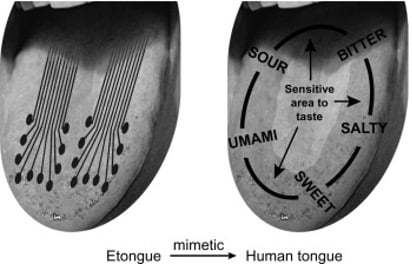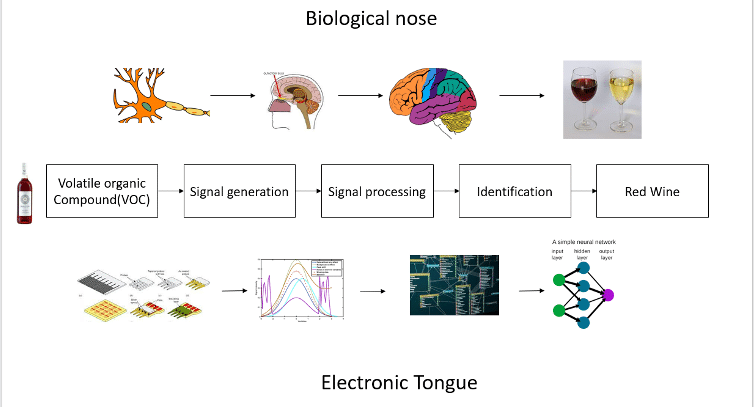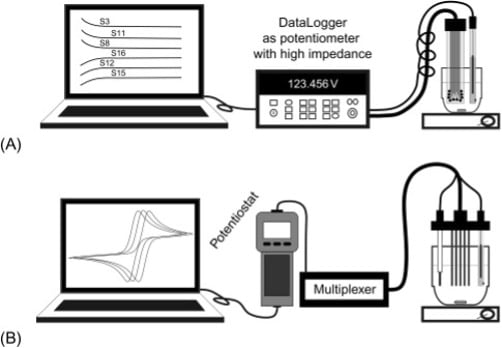The sense of taste plays a crucial role in our perception and enjoyment of food and beverages. Inspired by the human taste system, scientists and engineers have developed a remarkable technology known as the electronic tongue. An electronic tongue is a device designed to mimic the human gustatory system, capable of analyzing and distinguishing different tastes. This cutting-edge technology has found applications in various industries, including food and beverage, pharmaceuticals, and quality control.
Working Principle
The electronic tongue consists of a sensor array, a data processing system, and a pattern recognition algorithm. The sensor array comprises various types of taste sensors, each designed to respond to specific taste qualities such as sweet, sour, salty, bitter, and umami. These sensors are typically based on electrochemical, optical, or impedance-based principles.

When a liquid sample is introduced to the electronic tongue, it interacts with the taste sensors in the array. Each sensor generates a unique electrical response based on the specific taste components present in the sample. The data processing system captures and analyzes these responses to extract meaningful information about the taste profile of the sample.
The sensor array is a key component of the electronic tongue, responsible for detecting and analyzing taste characteristics in a sample. It consists of multiple taste sensors that work together to capture the taste profile of the analyzed substance.
The working principle of the sensor array involves the interaction between the taste compounds and the sensors’ surfaces. Each taste sensor in the array is designed to respond selectively or semi-selectively to specific taste qualities such as sweet, sour, salty, bitter, and umami. These sensors employ various technologies to convert the taste information into measurable signals.
Various types of sensors are used in electronic tongues, including:
1. Electrochemical Sensors: Electrochemical sensors measure changes in electrical properties, such as potential or impedance, in response to taste compounds. These sensors can be based on different principles, including amperometry, potentiometry, and impedance spectroscopy.
2. Optical Sensors: Optical sensors utilize light-based techniques to detect and measure changes in the optical properties of taste compounds. These sensors may employ principles such as absorbance, fluorescence, or surface plasmon resonance to capture taste information.
3. Potentiometric Sensors: Potentiometric sensors measure changes in electrical potential at the sensor-electrolyte interface when exposed to taste compounds. These sensors utilize ion-selective electrodes that respond selectively to specific ions associated with taste qualities.
4. Microfluidic Sensors: Microfluidic sensors employ miniaturized channels or chambers that allow for controlled fluid flow and interaction with taste compounds. These sensors can measure changes in electrical conductivity, impedance, or other parameters to detect and characterize taste.

The response signals from the sensor array are captured and processed by the electronic tongue’s data processing system. The system analyzes the signals using pattern recognition algorithms, comparing them with a pre-existing database of known taste profiles. This comparison enables the electronic tongue to identify and classify the taste based on the closest match in the database.
The selection and combination of sensors in the array are critical for achieving accurate taste analysis. Different sensors offer varying selectivity, sensitivity, and response times to specific taste qualities. By utilizing a diverse array of sensors, the electronic tongue can effectively capture and analyze the complex taste compositions of various substances, enabling reliable taste identification and discrimination.
Data Analysis and Pattern Recognition
The captured electrical signals from the sensor array are processed and analyzed using advanced data analysis techniques. The pattern recognition algorithm compares the obtained response pattern with a pre-existing database of known taste profiles. This comparison enables the electronic tongue to identify and classify the taste based on the closest match in the database. The database is built through the training of the electronic tongue with a wide range of taste samples, ensuring accurate taste identification and discrimination.

Applications
1. Food and Beverage Industry: Electronic tongues are extensively used in the food and beverage industry for quality control and flavor optimization. They can assess the taste profile of ingredients, monitor production processes, detect adulteration or contamination, and evaluate the sensory characteristics of finished products.
2. Pharmaceutical Industry: Electronic tongues find applications in pharmaceutical research and development. They can aid in the formulation of oral medications by assessing taste characteristics, optimizing flavors, and evaluating the impact of excipients on taste perception.
3. Environmental Monitoring: Electronic tongues can be employed in environmental monitoring to analyze the taste of water samples. They can detect changes in taste due to pollution, helping to identify contaminants and assess water quality.
4. Sensory Analysis and Research: Electronic tongues are valuable tools in sensory analysis and research, allowing for objective and quantitative measurements of taste. They enable the study of taste preferences, the evaluation of new taste enhancers or substitutes, and the understanding of taste interactions.
Advantages
The electronic tongue offers several advantages over traditional taste-sensing methods:
1. Objective and Reproducible: Electronic tongues provide objective and reproducible taste measurements, reducing the subjective nature of human sensory evaluations.
2. Rapid Analysis: Electronic tongues offer fast and real-time taste analysis, enabling efficient quality control and process optimization in industries.
3. Wide Range of Applications: Electronic tongues can be adapted for various liquids, including complex mixtures and non-consumable substances, expanding their applicability beyond food and beverages.
4. Cost-Effective: Electronic tongues can be a cost-effective alternative to human sensory panels, reducing the need for extensive taste testing and panel training.
Conclusion
The electronic tongue has emerged as a powerful technology for taste analysis and classification. By mimicking the human gustatory system and employing advanced data analysis techniques, electronic tongues provide valuable insights into taste profiles and play a crucial role in industries such as food and beverage, pharmaceuticals, and environmental monitoring. With ongoing advancements, electronic tongues are poised to enhance product development, quality control, and sensory research in diverse fields.
Duraiarasu E, IVth year, B.E ECE, Rajalakshmi Engineering College, Chennai, Tamil Nadu.





